Pinisi
The term pinisi or phinisi refer to a type of rig, the masts, sails and the configuration of the ropes (‘lines’) of Indonesian sailing vessels. It was mainly built by the Konjo people, an ethnic group in the Bulukumba regency of South Sulawesi, but was, and still is used widely by Buginese and Makassarese seafarers, mostly for inter-insular transportation, cargo and fishing purposes within Indonesian archipelago.
| Pinisi, art of boatbuilding in South Sulawesi | |
|---|---|
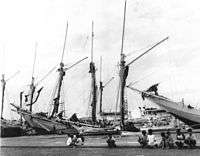 Pinisi boats at the port of Paotere in Makassar, 1994 | |
| Country | Indonesia |
| Reference | 1197 |
| Region | Asia and the Pacific |
| Inscription history | |
| Inscription | 2017 (12th session) |
| List | Representative |
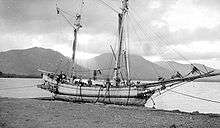
UNESCO designated Pinisi boat-building art as Masterpiece of Oral and Intangible Heritage of Humanity at the 12th Session of the Unique Cultural Heritage Committee on Dec 7, 2017.[1] The vessels using pinisi rig (palari, lambo, and PLM) were the largest Bugis traditional vessel, and also the largest Indonesian traditional vessel, after the disappearance of giant jong.[2]
Etymology
According to a local tradition the name pinisi is given by a Tallo king, I Manyingarang Dg Makkilo, for his boat. The name comes from two words, that is "picuru" (meaning "good example"), and "binisi" (a type of small, agile and tough fish on the surface of the water and not affected by currents and waves).[3]
Another source stated that the name pinisi comes from word panisi (Bugis word, means insert), or mappanisi (inserting), which refers to caulking process. As lopi dipanisi means caulked vessel, it has been suggested that the word panisi undergoes phonemic alteration to pinisi.[4]
Another etymology has pinisi come from the Dutch pinas,[5] itself from the Spanish pinaza c. 1240, from pino (pine tree), from the wood of which the ships were constructed.
General description
A pinisi-rigged vessel sets seven to eight sails on two masts, arranged in a way akin to a schooner-ketch: called a 'schooner' because all of its sails are ‘fore-and-aft’ sails, lined up along the centreline of the hull on two masts; and called ‘ketch’, because the mast in the ship’s aft is somewhat shorter than the one in the bow.[6]
The large mainsails differ from western style gaff rigs though, as they often do not have a boom and the sail is not lowered with the gaff. Instead it is reefed towards the mast, much like a curtain, thus allowing the gaff to be used as deck crane in the harbour. The lower part of the mast itself may resemble a tripod or is made of two poles.
The original pinisi-rigged ship (palari), is about 50–70 feet (15.24-21.34 m) in length overall, with light laden waterline of 34–43 feet (10.36-13.1 m).[7]:112–113 Smaller palari is only about 10 m in length.[8] In 2011 a large pinisi-rigged PLM has been completed in Bulukumba, South Sulawesi. It is 50 m long and 9 m wide, the tonnage is about 500 tons.[9]
Types of hull
There are two general types of hull using the Pinisi rig.[10]
- Palari. Older type of Pinisi with a curved stern and keel. They were usually smaller than the Lamba and used 2 quarter rudder mounted at the side of the stern. Motorized version usually had single mechanized rudder behind its propeller, but majority of motorized vessel favored the lambo hull.
- Lamba or lambo. Pinisi of a long and slender built, having a straight stern. This type of Pinisi is the one currently surviving in its motorized version (PLM). Used single mechanized axial rudder, but some retained the quarter rudder for aesthetic purpose.
History
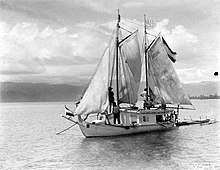
In the 19th century, Sulawesian sailor began to combine the traditional tanja rig with fore-and-aft rig from Western ships sailing through the archipelago. Pinisi evolved from the base hull of Padewakang with front-and-aft rig to its own hull model with a native "pinisi rig". During these evolutionary decades, Indonesian sailors and shipbuilders changed some features of the original western schooner. The first Sulawesian pinisi was thought to has been first built in 1906 by the shipuilders of Ara and Lemo-Lemo, they built the first penisiq [sic] for a Bira skipper.[11]
At first, schooner rig was applied to padewakang hull, but eventually the sailor used the faster palari hull instead. Almost the whole hull is cargo room, only a small cabin placed at the stern serve as captain's room, meanwhile the crew sleep on the deck or cargo room. The usage of double quarter rudder is retained.
Since the 1930s, this sailing ship adopted a new type of sail, the nade sail, which came from cutters and sloops used by Western pearl seekers and small traders in Eastern Indonesia. In the 1970s more pinisi were equipped with engines, which favored the use of lambo type hull. Because the sails only used as complement to the engine, the sails were removed, but some vessels retained its masts. These type of ships are called Perahu Layar Motor (PLM) - Motorized Sailing Vessel.
In the subsequent years the cargo capacity of pinisi increased to an average of 300 tons. Nade sails used on medium-sized ships, and the larger ships used pinisi rig. But because the masts became shorter due to installed engine as propulsion, the sails are only used in favorable winds.
Design and construction
Several parts of the pinisi are referred to by their original Buginese names, such as:
- Anjong, (balancing triangle) located at the front deck (Anjungan)
- Sombala, (main sail) the largest sail in the ship
- Tanpasere, (small sail) triangle-shaped sail, located at each mast
- Cocoro pantara (front additional sail)
- Cocoro tangnga (middle additional sail)
- Tarengke (row additional sail)
Modern use
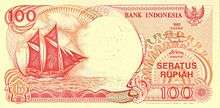
Today, pinisi mainly used for trade, serves as inter-insular cargo, such as to transport timber from Kalimantan to Java, in exchange to transporting grocery and goods from industrialized Java to more remote ports in Indonesian archipelago. Pinisi often frequent traditional ports, such as Sunda Kelapa port in Jakarta, Surabaya, Banjarmasin, and the port of Makassar.
As with many traditional ship types, pinisi have been provided with motors, largely since 1970. This has changed the appearance of the ships. Comparable to modern dhows, the masts have been shortened, or omitted as deck cranes vanished completely, while structures on deck, usually aft, have been enlarged for the crew and passengers. In the early 1970s thousands of pinisi-palari ships measuring up to 200 tonnes of cargo, the world's largest commercial sailing fleet at the time, had contacted all corners of the Indian Ocean and became the trading backbone of the people.
The pinisi is modified into diving charter boat by foreigner investors for tourism purposes. One such example is that the boat is use as a pitstop for The Amazing Race.
References
- "UNESCO Acknowledges Pinisi as Intangible Cultural Heritage". Tempo. Retrieved 10 December 2017.
- Zainun, Nazarudin (2015). Antropologi Dan Sejarah Dalam Kearifan Tempatan. Penerbit USM.
- Koro, Nasaruddin (2006). Ayam Jantan Tanah Daeng: Siri' dan Pesse dari Konflik Lokal ke Pertarungan Lintas Batas. Ajuara. ISBN 9791532907.
- Saenong, Muhammad Arief (2013). Pinisi: Panduan Teknologi dan Budaya. Penerbit Ombak.
- Sailing the Asian Seas - Phinisi Schooners - Part 2 Archived April 25, 2012, at the Wayback Machine
- Liebner, Horst H. (2018). Pinisi: The Art of West-Austronesian Shipbuilding. Seoul: National Research Institute of Maritime Cultural Heritage & ICHCAP.
- Gibson-Hill, C.A. (February 1950). "The Indonesian Trading Boats reaching Singapore". Journal of the Malayan Branch of the Royal Asiatic Society. 23: 108–138 – via JSTOR.
- Liebner, Horst H. (November 2016). "Perahu Nusantara - sebuah presentase bagi Menko Maritim". Academia. Retrieved 13 August 2019.
- Sastrawat, Indra (22 November 2011). "Largest Pinisi Launched". Kompasiana. Retrieved 15 July 2018.
- Michael Kasten: The Indonesian Phinisi
- Liebner, Horst H. and Rahman, Ahmad (1998): 'Pola Pengonsepan Pengetahuan Tradisional: Suatu Lontaraq Orang Bugis tentang Pelayaran ', Kesasteraan Bugis dalam Dunia Kontemporer (Makassar).
Further reading
- G. Adrian Horridge, The Konjo boatbuilders and the Bugis Prahus of south Sulawesi, National Maritime Museum, London 1979.
- 2004 Horst H. Liebner, Malayologist, Expert Staff of the Agency for Marine and Fisheries Research, Department of Marine Affairs and Fisheries of the Republic of Indonesia
External links
| Wikimedia Commons has media related to Pinisi. |
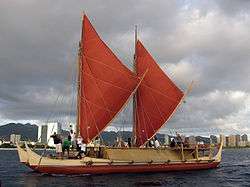

.jpg)
